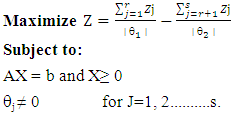-
Paper Information
- Previous Paper
- Paper Submission
-
Journal Information
- About This Journal
- Editorial Board
- Current Issue
- Archive
- Author Guidelines
- Contact Us
American Journal of Operational Research
p-ISSN: 2324-6537 e-ISSN: 2324-6545
2019; 9(1): 8-11
doi:10.5923/j.ajor.20190901.02

Improved Scalarizing Techniques for Solving Multi-objective Optimization Problems
Chandra Sen
Professor (Rtd.), Department of Agricultural Economics, Institute of Agricultural Sciences, Banaras Hindu University, Varanasi, India
Correspondence to: Chandra Sen, Professor (Rtd.), Department of Agricultural Economics, Institute of Agricultural Sciences, Banaras Hindu University, Varanasi, India.
| Email: |  |
Copyright © 2019 The Author(s). Published by Scientific & Academic Publishing.
This work is licensed under the Creative Commons Attribution International License (CC BY).
http://creativecommons.org/licenses/by/4.0/

Several scalarizing techniques are used for solving multi-objective optimization (MOO) problems. Most of these scalarizing techniques were found inefficient in obtaining an appropriate solution of MOO problems. The study proposed improved scalarizing techniques for solving multi-objective optimization (MOO) problems. The improved scalarizing techniques using mean, harmonic mean and geometric mean have been applied for solving two MOO problems and generated satisfactory solutions.
Keywords: Improved Scalarizing Technique, Multi-Objective Optimization (MOO), Mean, Harmonic Mean, Geometric Mean
Cite this paper: Chandra Sen, Improved Scalarizing Techniques for Solving Multi-objective Optimization Problems, American Journal of Operational Research, Vol. 9 No. 1, 2019, pp. 8-11. doi: 10.5923/j.ajor.20190901.02.
Article Outline
1. Introduction
- The scalarizing technique was first introduced in year 1983 [1] for solving MOO problems. The technique has been successfully used for resource use planning in agriculture for increasing farm income, increasing farm employment with lesser use of fertilizer, irrigation etc. [2] [3]..[10]. Several new averaging techniques [11] [12]… [27] using mean, harmonic mean and geometric mean have been proposed during last three decades. Most of these scalarizing techniques have been found inefficient in generating the acceptable MOO solutions [28] [29]. The improved scalarizing techniques are proposed for generating compromising and acceptable solutions of MOO problems.
2. Multi-Objective Optimization Problem
- For optimizing ‘n’ objective functions with maximization of ‘r’ objective functions and minimization of remaining ‘n-r’ objective functions. The MOO problem is formulated as described below:Optimize Z = [Max.Z1,Z2…….Zr, Min. Zr+1,……..Zn]Where,
 Subject To:AX = b and X ≥ 0
Subject To:AX = b and X ≥ 02.1. Existing Scalarizing Techniques
- There are many scalarizing techniques for solving MOO problems. The scalarizing techniques using mean, geometric mean and harmonic mean have been explained with an example. The multi-objective function is constructed by scalarizing each objective function by the mean, geometric and harmonic mean of optimal values of objective functions as described below:
 Where, │θ1│= Mean, Geometric Mean and Harmonic Mean of optimal values of maximization objective functions. │θ2│= Mean, Geometric Mean and Harmonic Mean of optimal values of Minimization Objective functions.Note: The estimation of θ1 and θ2 is not logical when objective functions are of different dimensions.
Where, │θ1│= Mean, Geometric Mean and Harmonic Mean of optimal values of maximization objective functions. │θ2│= Mean, Geometric Mean and Harmonic Mean of optimal values of Minimization Objective functions.Note: The estimation of θ1 and θ2 is not logical when objective functions are of different dimensions.2.2. Improved Scalarizing Techniques
- The multi-objective function is constructed as explained below:
 Where,│C1│ = Mean, Harmonic mean (Hm) or Geometric mean (Gm) of Cj values of Maximization objective functions│C2│ = Mean, Harmonic mean (Hm) or Geometric mean (Gm) of Cj values of Minimization objective functionsNote: The multi-objective function is free from the problem of multi dimensions aggregation.
Where,│C1│ = Mean, Harmonic mean (Hm) or Geometric mean (Gm) of Cj values of Maximization objective functions│C2│ = Mean, Harmonic mean (Hm) or Geometric mean (Gm) of Cj values of Minimization objective functionsNote: The multi-objective function is free from the problem of multi dimensions aggregation.3. Solving MOO Problem
- Example The following example for achieving four objective functions has been solved using both existing and improved scalarizing techniques.Max. Z1 = 12500X1 + 25100X2 + 16700X3 + 23300X4 + 20200X5Max. Z2 = 21X1 + 15X2 +13X3 + 17X4 + 11X5Min. Z3 = 370X1 + 280X2 + 350X3 +270X4 + 240X5Min. Z4 = 1930X1 + 1790X2 + 1520X3 + 1690X4 + 1720X5Subject to:
 All the objective functions have been optimized individually and the solution is presented in Table 1.
All the objective functions have been optimized individually and the solution is presented in Table 1.
|
|
|
4. Conclusions
- There are several scalarizing techniques used for solving MOO problems. The mean, geometric mean and harmonic mean have been frequently used for scalarizing the objective functions. The solutions of MOO problems generated using these techniques were not superior. However the improved scalarizing techniques using mean, harmonic mean and geometric mean are found superior and efficient in solving MOO problems for obtaining compromising solutions.
 Abstract
Abstract Reference
Reference Full-Text PDF
Full-Text PDF Full-text HTML
Full-text HTML

